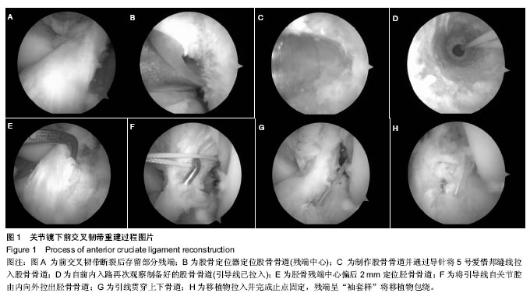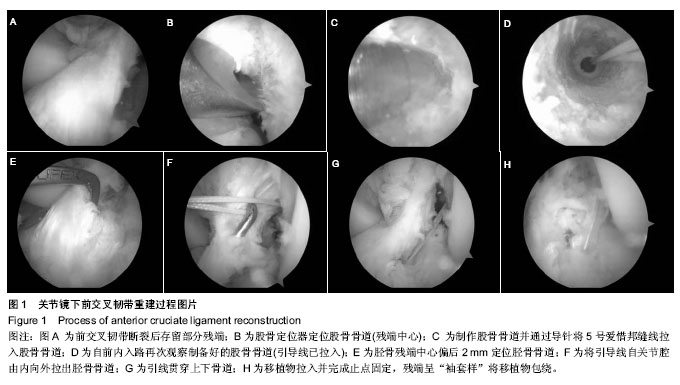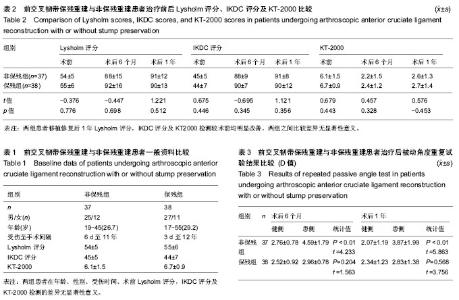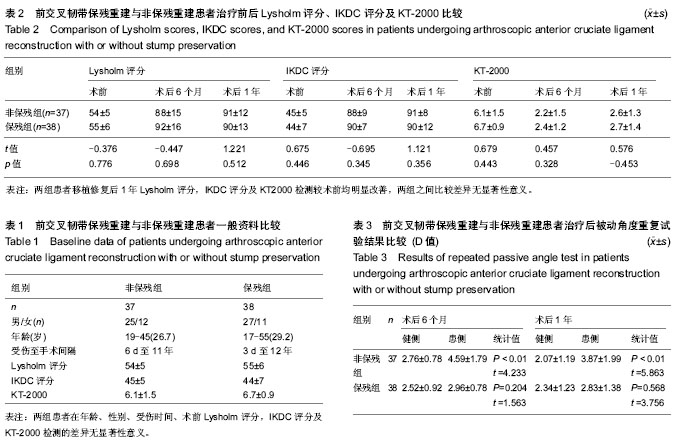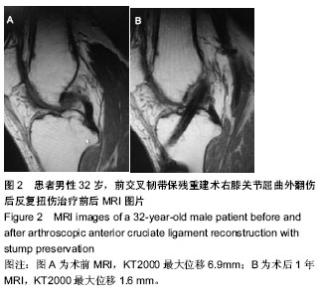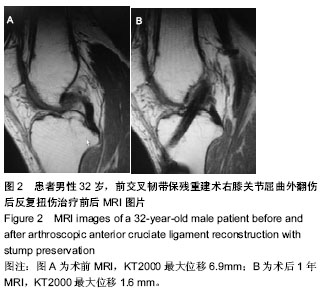| [1] Ghodadra N, Mall NA, Karas V,et al .Articular and meniscal pathology associated with primary anterior cruciate ligament reconstruction.J Knee Surg.2013;26:185-194.
[2] Cournapeau J,Klouche S,Hardy P.Material costs of anterior cruciate ligament reconstrutcion with hamstring tendons by two different techniques.Orthop Traumatol Surg Res.2013; 99(2):196-201.
[3] 刘彩龙,赵金忠.应用腘绳肌肌腱重建ACL的理论与技术实施特征[J].中国组织工程研究与临床康复,2008,12(20):3930-3934.
[4] Ishibashi Y, TsudaE,Tazawa K, et al. Intraoprative evaluation of the anatonmical double anterior cruciate ligament reconstruction with the orthoPilot navigation system. Orthopedics.2005;28:1277-1282.
[5] Meredick RB,Vance KJ,Appleby D,et al.Outcome of single-bundle versus double-bundle reconstruction of the anterior cruciate ligement:a meta-analsis.Am J Sports Med. 2008;36:618-628.
[6] Seong Hwan Kim,Young Bok Jung,Min Ku Song,et al.Comparison of double-bundle anterior cruciate ligament(ACL)reconstruction and single-bundle reconstruction with renmnant pull-out suture.Knee Surgery Sports Traumatology Arthoscopy.2014;22(9):2085-2093.
[7] Barrett DS. Proprioception and function after anterior cruciate reconstruction.J Bone Joint Surg Br.1991;73:833-837.
[8] Buelow JU;Siebold R;Ellermann A A prospective evaluation of tunnel enlargement in anterior crueiate ligement reconstruction with hamstrings:extracortical versus anatomical fixation. Knee Surgery Sports Traumatology Arthroscopy.2002;10:80-85.
[9] 王成,敖英芳.ACL重建术后骨道增宽的临床研究[J].中华外科杂志,2008,46(2):90-93.
[10] Unterhauser FN, Bail HJ,Hoher J,et al. Endoligamentous revascularization of an anterior cruciate ligament grafe.Clin Orthop Relat Res.2003;414:276-288.
[11] Gohil S,Annear PO, Breidahl W.Anterior cruciate ligement reconstruction using autologous double hamstings:a comparison of standard versusminimal debridement techniques using MRI to assess revascularisation.A randomised prospective study with a one-year follow-up.J Bone Joint Surg Br.2007;89(9):1165-1171.
[12] 孙磊,吴波,田敏,等.保留与切除残疾ACL重建移植物形态学比较[J].中国运动医学杂志.2012,31(7) .
[13] 沈梅,金可心,毛世刚,等.前交叉韧带重建后本体感觉训练前后步行参数变化的计算机辅助三维步态分析系统比较[J].中国组织工程研究与临床康复,2011,15(48):8947-8950.
[14] 罗文明,刘儒森,王修超,等.关节镜下半腱肌和股薄肌双束重建ACL后膝关节本体感觉的功能评定[J],中国组织工程研究与临床康复,2009,13(11):2162.
[15] Dhillon MS,Bali K,Vasistha RK. Immunohistological evaluation of proprioceptive potential of the residual stump of injured anterior cruciate ligaments.Int Orthop.2010;34(5): 737-741.
[16] Adachi N,Ochi M, Uchio Y,Sumen Y,Sumen Y,Anterior cruciate ligement augmentation under archroscopy.A minimum 2-year follow-up in 40 patients. Arch Orthop Trauma Surg.2000;120(3-4):128-133.
[17] Adachi N,Ochi M, Uchio Y,et al.Mechanoreceptors in the anterior cruciate ligement contribute to the joint position sense.Acta Orthop Scand.2002;73(3)330-334.
[18] Lee BI,Kwon SW,Kim JB,et al.Comparison of clincal results according to amount of preserved remnant in arthroscopic anterior cruciate ligement reconstruction using quadrupled hamstring graft.Arthroscopy.2008;24(5):560-568.
[19] 董向辉,凌鸣,冯伟楼,等.关节滑液对兔ACL重建后腱骨愈合生物力学及组织学的影响[J].中国组织工程研究.2012,16(11): 1937-1940.
[20] Lee BI,Min KD,Choi HS,et al.Arthroscopic anterior cruciate ligament reconstruction with the tibial-remnant preserving technique using a hamstring graft.Arthroscopy.2006;22(3):340.
[21] 洪雷,李旭,王雪松,等. 关节镜下保留残端重建前交叉韧带的临床前瞻性对照研究[J].中华外科杂志,2011;49(7):586-591.
[22] Jihoon Cha,Sang-Hee Chio,Jong Won Kwon et al.Analysis of cyclops lesions after different anterior cruciate ligament reconstruction:a comparision of the single-bundle and remnant bundle preservation techniques.Skeletal Radiology. 2012;41(8):997-1002 |
